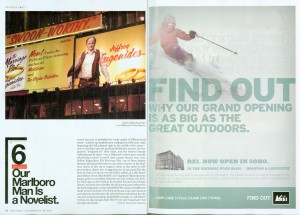Going to Digital Book World? Verso’s Tom Thompson will be speaking 3-3:50PM on Thursday, January 15 on “Strategies for Digital Advertising and Managing Paid Media Campaigns” with paid media experts from Penguin Random House, Scholastic, and Hachette.
Tag Archives: advertising
Spring Newsletter
The Spring Newsletter is here. Check it out for new ideas in data-driven marketing.
Our #1
Reason #6 in New York magazine’s “Reasons to Love New York” is our #1: “Our Marlboro Man Is a Novelist.”
This is a case study in the right billboard in the right place at the right time. Congratulations to Verso’s media team for sniffing out the opportunity, Verso’s design team for a billboard that stood tall in the Times Square glare, and Jeffrey Eugenides for writing the novel that inspires us all.
How do you sell a $60 dictionary in an online world?
We are proud to be working with Houghton Mifflin Harcourt on their blockbuster marketing campaign to launch the 5th edition of their American Heritage Dictionary. How beautiful, comprehensive, and connected does a print dictionary have to be in this day and age to pay $60 for it? Just walk into a bookstore and pick one up, you’ll see.
We think this edition provides a great example of how to create the kind of print experience readers crave while also providing the connectivity they require. In publishing, as in advertising, you have to know your medium and know your audience.
Here’s a link to the New York Times article about the campaign and Verso’s role in it.
“Surprising and delightful”*

As an advertising agency, part of our job is to keep our clients up-to-date on late-breaking availabilities, good deals, and what’s newly possible. Sometimes it’s a homepage takeover, sometimes it’s a full page print ad, and sometimes it’s a prominent billboard.
We are big fans of Jeffrey Eugenides’ work and his latest book in particular. So we were thrilled when Farrar, Straus and Giroux gave us the go-ahead for a Times Square billboard for his amazing new novel, “The Marriage Plot.” OK, maybe a little surprised, but FSG has always been good at keeping us on our toes. Our design and production team had a blast working on the creative.
The board has been up for 24 hours and already the notices are coming in:
The Village Voice says it’s “Crazy… and kind of cool.”
*Peter Lattman, New York Times DealBook reporter calls it “Surprising and delightful.”
AdWeek says “FSG goes big.”
Shelf Awareness calls it “Impressive and dramatic.”
Check it out for yourself. And read the book. It really is THAT good.

New Adventures in Contextual Marketing (and the Death of the Dancing Cowboy)
The financial collapse of 2008 did this one good deed: it killed the dancing cowboy mortgage ads. The dancing cowboys and their variations seemed to rule the internet in the years before 2008. Their endless loops of rotating .gifs were infuriatingly impossible to avoid, running mercilessly, irrelevantly adjacent to whatever you were trying to read, watch or look at. The makers of the ads couldn’t care less whether they ran on a site devoted to politics, motherhood, or game development. After all, who didn’t need an enormous time-bomb of an adjustable rate mortgage on a house they couldn’t otherwise afford?
There are certainly brands that use blind mass reach effectively. High-volume low-cost reach makes sense for a company like Coca Cola, for example, that not only truly appeals across all demographics and interest levels but also has the budget to market accordingly. Book advertising, however, is a radically different kind of product with a radically different budget. Whether a reader is a fan of Daniel Silva’s thrillers or Suze Orman’s guides to personal finance and empowerment, the decision to buy a book is highly personal and nuanced. Often the greatest indicator of what you want to read next is what you have just read. And that is why we believe in context first marketing.
Context first means serving an ad for a book next to the most relevant news, blog or entertainment content. It means creating an ad for a parenting book within the Parenting magazine iPad app that provides the user with new insights into parenting. Dancing cowboys might get your visual attention, but they work to distract you from what you came to the site looking for in the first place. Context first advertising gives you information relevant to the site you’re on and provides an opportunity to go farther. Our job is not to stop readers from finding what they want, it’s to help them find more of what they want.
This is not a new philosophy for Verso Advertising. It has governed our media planning and creative development from the day we opened our doors. What’s a book ad in the NYTBR, after all, other than a contextually relevant ad? But while the philosophy isn’t new, the toolkit is. Digitals products are creating proliferating opportunities for contextual marketing—from Verso’s own Reader Channels to integrated sponsored content on mobile apps to rich media opportunities on every device.
One of these new opportunities is a venture that connects social media, engagement advertising, and contextual relevance in interesting and affordable ways: Say Media. Rich media used to be beyond the budgets of many of our publishing clients. Between ad construction and serving, it simply cost too much—even though the content offering and engagement benefits were clear. Say Media, however, builds rich media creative development, social linkage, and premium ad serving into every campaign budget—making campaigns affordable for medium- to high-profile book publishing projects. While some rich media such as full-page takeovers can be intrusive and disruptive to user experience, Say Media ads respect users first: an in-ad countdown banner indicates that the cursor is hovering and about to expand the ad window, and helps users avoid accidental clicks. They sell on a CPE (cost per engagement) model, so they have a material interest in serving the ad only to the most interested audience. If your project has interesting peripheral content available—a quiz, a game, a video, a slideshow of photos—an ad with Say Media can show interested readers the way to your book.
Beyond the click through — updated
Two years ago I posted that advertisers need to move beyond the click through.
Things haven’t changed much it seems. MediaPost reported yesterday on new research by ad network and technology provider Collective that suggests that click through behavior does not closely track buyer behavior. Some highlights:
> Online gamers clicked 43% more often than non-gamers. But did they buy more?
> Users on mobile devices click 123% more often than users on laptops and desktops. But happens after the click?
> Here’s where you see the break between CTR and sales: “the highest-performing CTR campaigns examined (top 20%) had a 150% higher CTR but an 8% lower post-impression action rate.”
Of course CTR still matters. But it has to be looked at in conjunction with context, creative, impressions delivered, and sales.
Reaching readers through social networks
We know book readers are online, but where can we find them? The first place to look is on the major social networks, particularly Facebook. As reported in the May 18 New York Times, Nielsen confirmed that “Internet use for ‘short-tail’ sites with large audience reach has evolved since 2003. The change is from portal-oriented sites…to social networks.”
Facebook v. MySpace
While social networks were defined for a time by MySpace, American audiences—particularly the audience most likely to purchase a book—have gravitated primarily to Facebook. Despite its recent tailspin, MySpace remains a vibrant network for users interested in music. But for nearly every other category of interest, Facebook is now number one.
In the last six months alone, Facebook has grown from 50 million active U.S. users to 55 million and gains more everyday. Importantly for publishers, the fastest growing demographic is age 35+. It’s now even bigger than the 18-24 age bracket.
Advertising on Facebook, however, can be a challenge. By design, Facebook hampers our ability to deliver premium ad content and determine relevant location, pushing ads off to the side in an unobtrusive column with a small, single, static .jpg for art and limited room for copy. Facebook’s ability to micro-target means that ads do perform reasonably well on the network—in line with most online CTRs of .1-.12%–but certainly not as well as they could given the network’s ideal demo for readers.
Facebook Applications
Verso Digital currently recommends running campaigns on Facebook apps instead of on Facebook itself. Apps keep users within the FB environment and have all the advantages of Facebook—viral connectivity, ease of use, user engagement, and micro-interest ad targeting. But apps offer several unique advantages, including a pool of highly engaged users (and thus increased potential for viral outreach), greater creative flexibility (including flash and video-enabled rich media), and superior adjacency to relevant content. Recent campaigns have shown not only a significantly higher CTR with Facebook apps than with FB itself, but also an even more potentially powerful viral component. One of the most prominent examples of this viral potential is the “Visual Bookshelf” app: every time a reader puts a book on his or her “Visual Bookshelf” or writes a review, that message goes out to all of his or her Facebook Friends—120 on average. That’s a lot of value for each action taken. And it suggests another kind of answer for publishers and authors to the problem of shrinking book reviews. Neither blogs, GoodReads, or Facebook alone will answer the fill the gap left by disappearing print book review publications. But each represents another strand in the fabric of how readers are making new decisions about what to read next.
New Bowker data on building book audiences through digital media
While book publishing faces its greatest challenges in decades, new Verso Digital initiatives aim to do more than simply gain market share in a declining market. Our goal is to grow readership by reaching out to each book’s interest-group in targeted, measurable ways across multiple digital platforms.
As readers’ attention shifts from print to digital media, the old ways of reaching potential readers no longer work as well as they have in the past. This migration of attention, coupled with declining foot traffic in brick-and-mortar bookstores, makes it imperative that we reach potential book buyers where they are most active and engaged with their subject matter.
The latest data from RR Bowker confirms that this migration has already occurred. For the first time, average hours spent online has recently passed hours spent watching TV. Consumers are increasingly learning about books online.
This shift means that book marketing needs to move from a mass mindset to a niche one. When ads are broadcast across mass channels such as national print newspapers, radio and TV, the ads need to speak as broadly and loudly as possible. But ads can no longer be merely disruptive plays for attention. With micro-targeting now possible across a multitude of devices, advertising should be considered a service rendered to particular, interested readers, not a blanket message aimed at them. That’s why we created Verso Reader Channels–to target a reader pre-disposed toward a particular book’s subject, when and where he or she is interested in learning about it. Doing so not only increases our chances of converting attention to a “buy,” but also increases the chance of the message spreading virally across networks of like-minded readers.
Verso Reader Channels Partner with Book: The Sequel
This year’s BEA was thrilling like a reverse roller coaster ride. Instead of the rush that comes from plunging from a coaster’s heights, this year’s show began in the trenches but quickly launched upwards through exciting conversations started in the aisles, over cocktails (especially at the Verso-sponsored BEATweetup), and among the terrifically diverse and focused information panels—including the inspiring 7x20x21 panel sparked by our own @DBerthiaume and turned into reality by Macmillan’s dynamic online marketing duo of Ryan Chapman and Ami Greko.


